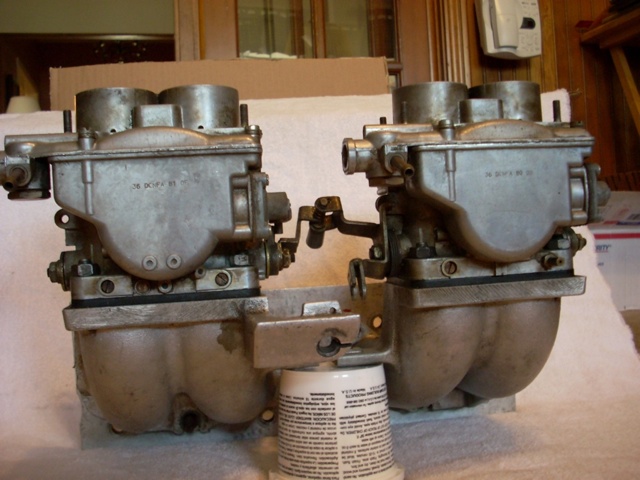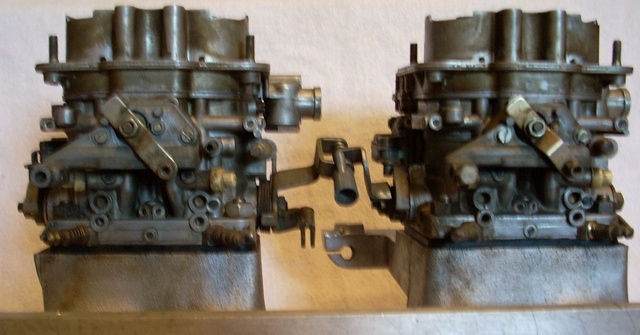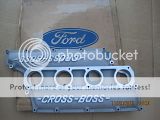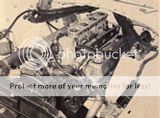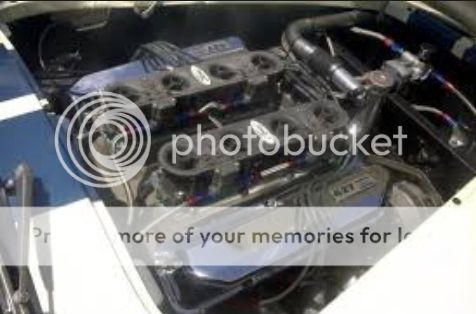The Germans with the Porsche 911 with Solex or Weber 3 chokes, the Saab 96 two strokes with the Solex 34w2 3 chokes, and then the Americans after trying to get twin carbs reliable found that your percentages on long term idle tuning success and ultimate performance was best found when individual port on port throttles had a unified control so each throttle stayed at the same throttle position.
The trap door 1954 Holley 4-bbl was first cut a proper throttle multiplication without tuning issues, then the 1957 312 y block 4150 4-bbl was second leap forward, but but for independent runner, port on port success, it was a lot longer.
The Solex 34w2 3 bbl found in the two stroke Saab 96 in bull-nose form was fully sorted, then the failure of the 911t's very poor Solex 3 and Weber 3 bbls forced Bosch to make a sigle throttle body serve six cylinders. Ford was in despite with the Government over anti trust matters, sot eh Autolite company was bankrupted to become Motorcraft with a large , typically insider trading like Ford write down in value. This meant the Autolite was a disputed item with Bendix Technico. After being bitten by their early systems in performance Pre 1974 Aston Martin DBS V8's, Jag v12 prototypes, Maserati's, Benz's, Chevy Vega Cosworths, and Triumph 2500 Pi's, Bendix, Bosch, Bico and Lucas were rushing headlong to single throttle body EFI; from the Space Age, and electronic machine control work, they all knew electronic pulse width or solenoid operation was going to be where reliability was at for the 70's and 80's.
The early inline Autolites were very bad with respect to idle and fuel delivery, Ford had to do a lot of work to make them pass emissions. The last 1973 351 C twin inline Autolite set up Ak Miller tested when he was still with Ford was sublimely settled with respect to idle, and yet still had massive performance. And it used many stock 1100 parts. Because of this, it was dead in the water.
Today, an I6 tunnel ram exists. Two Solex 34w2's with 29 mm chokes would do a pretty good job up to 5000 rpm on a 200 Ford.
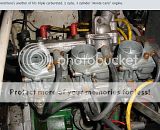

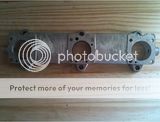
From a Saab site


The four bolt Solex carbs are rare, but the Scandinavians are making again the Monte Carlo and long nose triple carb parts again. The triple choke simultaneous throttle bodies can take a four bolt 1-bbl Solex easily. Solex is now part of Weber Marelli after the French sold it to Pierburg in the early 1980's, so Solex stuff is kind hard to find. But what is great is that the Swedes figured out how to tune all three carbs together, and with a just a Chevy idle control solenoid, its possible to get six Solex carbs to run as a six pack of carbs with the right linkage parts.
They are still too tall to package on a 250 unless you do a hood bulge.
I went through the twin PMO remade IDA3 Weber set up (Lambo Muira, Lancia Statos, early Porsche 911) and its very good but has the normal long term reliability problems of throttle adjustment at 50000 miles. The whole reason those early POPIR systems failed was throttle balance when worn, something foreign to a 4-bbl Holley or 62, 65 or 70 mm Ford EEC 4 or 5 isolated runner EFI system.
The trap door 1954 Holley 4-bbl was first cut a proper throttle multiplication without tuning issues, then the 1957 312 y block 4150 4-bbl was second leap forward, but but for independent runner, port on port success, it was a lot longer.
The Solex 34w2 3 bbl found in the two stroke Saab 96 in bull-nose form was fully sorted, then the failure of the 911t's very poor Solex 3 and Weber 3 bbls forced Bosch to make a sigle throttle body serve six cylinders. Ford was in despite with the Government over anti trust matters, sot eh Autolite company was bankrupted to become Motorcraft with a large , typically insider trading like Ford write down in value. This meant the Autolite was a disputed item with Bendix Technico. After being bitten by their early systems in performance Pre 1974 Aston Martin DBS V8's, Jag v12 prototypes, Maserati's, Benz's, Chevy Vega Cosworths, and Triumph 2500 Pi's, Bendix, Bosch, Bico and Lucas were rushing headlong to single throttle body EFI; from the Space Age, and electronic machine control work, they all knew electronic pulse width or solenoid operation was going to be where reliability was at for the 70's and 80's.
The early inline Autolites were very bad with respect to idle and fuel delivery, Ford had to do a lot of work to make them pass emissions. The last 1973 351 C twin inline Autolite set up Ak Miller tested when he was still with Ford was sublimely settled with respect to idle, and yet still had massive performance. And it used many stock 1100 parts. Because of this, it was dead in the water.
Today, an I6 tunnel ram exists. Two Solex 34w2's with 29 mm chokes would do a pretty good job up to 5000 rpm on a 200 Ford.



From a Saab site


The four bolt Solex carbs are rare, but the Scandinavians are making again the Monte Carlo and long nose triple carb parts again. The triple choke simultaneous throttle bodies can take a four bolt 1-bbl Solex easily. Solex is now part of Weber Marelli after the French sold it to Pierburg in the early 1980's, so Solex stuff is kind hard to find. But what is great is that the Swedes figured out how to tune all three carbs together, and with a just a Chevy idle control solenoid, its possible to get six Solex carbs to run as a six pack of carbs with the right linkage parts.
They are still too tall to package on a 250 unless you do a hood bulge.
I went through the twin PMO remade IDA3 Weber set up (Lambo Muira, Lancia Statos, early Porsche 911) and its very good but has the normal long term reliability problems of throttle adjustment at 50000 miles. The whole reason those early POPIR systems failed was throttle balance when worn, something foreign to a 4-bbl Holley or 62, 65 or 70 mm Ford EEC 4 or 5 isolated runner EFI system.

